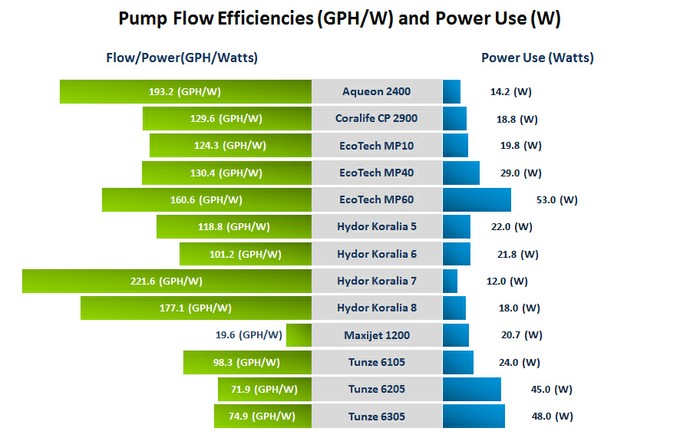Now that we have some real independent data on the flow output of propeller water pumps, it is possible to compare real world performance to the rated output of several propeller pumps. In the graph above produced by Sandford, Straka and Joshi, the advertised output flowrate is pictured in thick blue bars and the measured output flowrate is represented by thin green bars.
Where the green surpasses the blue, water pumps actually put out more flow than manufacturers claim. Where the green bars do not meet or exceed the length of the blue bars, the measured pump output is actually less than advertised. At a glance it is easy to see there are some big discrepancies between the the flow ratings of these propeller pumps and what volume of flow they actually produce.
Some of the clear over-performers in this study include the Vortech pumps from Ecotech Marine and the Hydor Koralia 5, all of which have a significantly higher output than what was advertised on the box. The Hydor Koralia 5 is rated for 1650 GPH but in this study it had a measured flowrate of nearly 2600 GPH while the Koralia 6, 7 and 8 were nearly identical in measured output as Hydor had advertised them.
Owners of Ecotech marine Vortech pumps will be extremely pleased to learn that the Vortech MP40 produces almost 600 GPH more than claimed while the MP10 and the MP60 both produced 1000 GPH more than what was advertised; you can now expect 2460 GPH from an MP10, 3781 GPH from an MP40 and 8500 GPH from the massive MP60.
The flipside of this propeller pump flow study is the big shortfall in the measured output of the larger Tunze Stream 2 pumps. The Tunze Stream 6105 rated at 3434 GPH was short by 31% with a measured output of 2358 GPH, the 6205 rated at 5811 GPH was short by 44% with a measured output of 3234 GPH and the Tunze Stream 6305 rated at 7925 GPH was short by 54% with a measured output of 3597 GPH.
Before Tunze Stream 2 owners go reaching for their pitchforks, keep in mind that these types of flow measurements are extremely hard to do. Up until the last couple of years, it would have been prohibitively expensive to buy or rent the kind of equipment necessary to measure the flow as performed in this study. There is an important note in the addendum to the paper about Tunze’s reaction to the results of the flow study:
Based on these results, Tunze conducted its own independent tests on the Tunze pumps and have confirmed our results. On further discussion with Tunze we do not feel the errors were deliberate attempts to mislead, but rather their misguided faith in theoretical calculations that often do not translate well into real world application and use. In light of these finding Tunze is working to remedy the situation.
Although the output and ratings of Tunze Stream 2 pumps show a big difference in output, it doesnt change the fact that many large successful reef tanks have been using large Stream pumps for many years. We have learned that Tunze has already begun to identify the reasons for the shortcomings between the calculated output of Tunze Stream pumps and their measured flow rate. Stay tuned for an official statement from Tunze which outlines their position on this study and how they have identified ways to actually increase the output of the 6105, 6205 and 6305 for existing owners of the Stream 2 propeller pumps.
Finally, it is also important to note that this study was made possible by Ecotech Marine as made very clear in the Acknowledgements:
We would like to thank EcoTech Marine for providing the large aquarium and renting the equipment needed for the study. The work was performed under the technical guidance and consultation with Bill Straka and Sanjay Joshi of Penn State University. The data was collected by Mike Sandford during his summer internship at EcoTech Marine.




